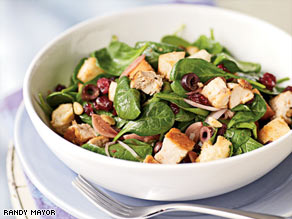Most of that added sugar comes from soft drinks and candy — a whopping 355 calories and the equivalent of guzzling two cans of soda and eating a chocolate bar.
By comparison, most women should be getting no more than 6 teaspoons a day, or 100 calories, of added sugar — the sweeteners and syrups that are added to foods during processing, preparation or at the table. For most men, the recommended limit is 9 teaspoons, or 150 calories, the heart group says.
The guidelines do not apply to naturally occurring sugars like those found in fruit, vegetables or dairy products.
Rachel K. Johnson, lead author of the statement published online Monday in the American Heart Association journal Circulation, said it was time to give specific advice on how much added sugar Americans should be getting, not just advising moderation.
"Take a good hard look at your diet," said Johnson, professor of nutrition at the University of Vermont in Burlington. "Figure out where the sources of added sugars are and think about how to cut back on that."
She said about 8 ounces of fruit-flavored yogurt has about 6 teaspoons of added sugar; 8 ounces of low-fat chocolate milk has about 4 teaspoons; a cup of frosted whole grain cereal has about 3 teaspoons.
The biggest culprits for the glut of sugar? Soft drinks by far, followed by candy, cakes, cookies and pies.
With about 8 teaspoons of added sugar, a regular 12-ounce soft drink will put most women over the recommended daily limit.
Cutting back on sugar likely won't be easy for many people, said Lona Sandon, a dietitian at Dallas' University of Texas Southwestern Medical Center.
"I think it's probably going to be a struggle for quite a few people," Sandon said.
Calculating one's sugar intake can be tricky as the government doesn't require labels to differentiate added sugars from naturally occurring sugars, said Johnson. But she points out that the biggest sources, like regular soft drinks and sweets, are pretty obvious. And the U.S. Department of Agriculture has a database for the added sugar in some foods.
To check for added sugar, look for a variety of ingredients including sugar, corn syrup, fructose, dextrose, molasses or evaporated cane juice on the label.
The heart group didn't recommend general limits for added sugar for children; a national health survey has shown that boys ages 14 to 18 consume an eye-popping 34 teaspoons of added sugar a day.
Sandon said that parents can help lower that sugar intake by getting soda out of the house, looking at how much sugar is in their kids' cereal and substituting snacks like cookies with popcorn.
Johnson concedes that sugar does play an important role in enhancing the taste of food, adding: "If you feel like, 'I just can't live with this low amount of sugar in my diet,' then what you need to do is up your energy needs."
In other words, she said, get moving. A man in his early 20s who walks more than three miles a day could consume about 288 calories, or about 18 teaspoons, of added sugar.
The statement says data indicates added sugar is contributing to Americans consuming too many discretionary calories — the number of calories remaining after a person eats the foods needed to meet nutrient requirements.
"We know for sure that if you are consuming excessive amounts of added sugar, you will add calories, which leads to weight gain, or you will displace other essential nutrients," she said.
On average, most women need about 1,800 calories a day and most men need about 2,200, Johnson said.
If someone drinks their daily calorie needs in soft drinks, they will be maintaining their weight, but won't be getting any nutrients, she said.
Wahida Karmally, nutrition director at Columbia University's Irving Institute for Clinical and Translational Research, said that with these guidelines, it's important to remember overall moderation. Some people, for instance, might be doing fine in their sugar consumption but are overdoing it on fat.
"I don't want people to go back thinking if I just cut back on teaspoons of sugar I'm going to be very healthy," she said.










![Reblog this post [with Zemanta]](http://img.zemanta.com/reblog_e.png?x-id=5e700f0e-bc9e-4847-8881-823b3c9f6853)







